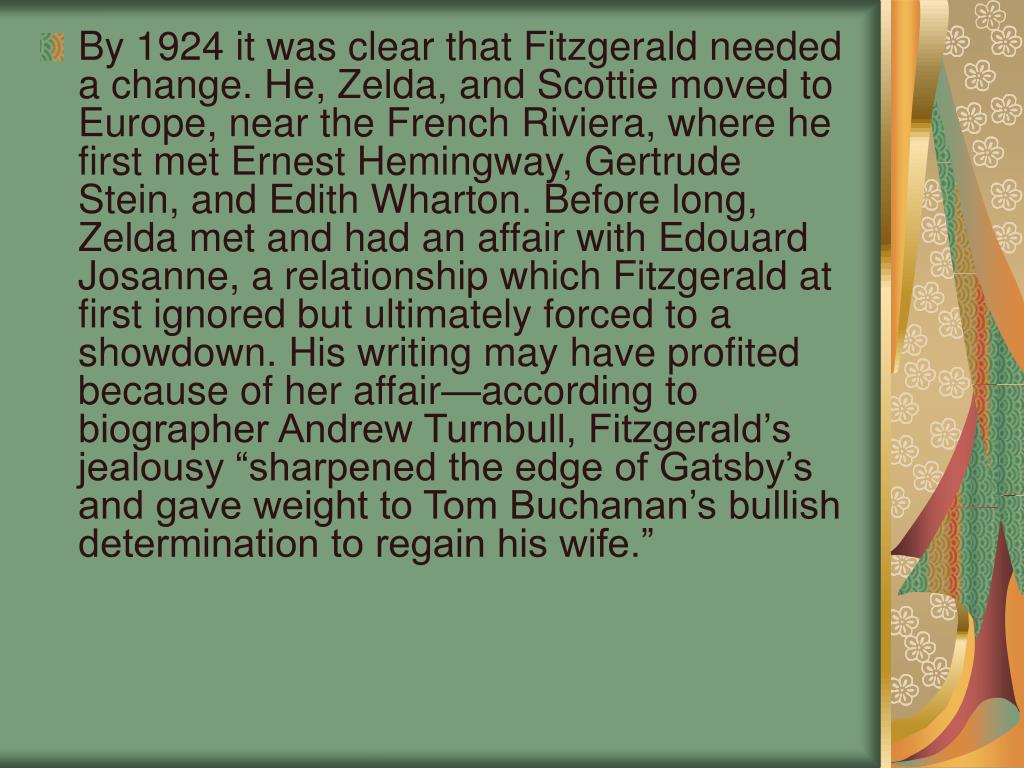The Real-Life Men Behind F. Scott Fitzgerald's The Great Gatsby

Table of Contents
The Prototype of Jay Gatsby: Examining the Real-Life Influences
The Mysterious Millionaire: Examining the influence of several wealthy, enigmatic figures on Gatsby's persona.
-
The Influence of Fitzgerald's Acquaintances: Fitzgerald moved in circles populated by wealthy and often enigmatic figures during the Roaring Twenties. These individuals, with their lavish lifestyles and often shadowy sources of income, undoubtedly contributed to Gatsby's persona. While pinpointing one specific person as the inspiration is impossible, individuals like the notorious bootlegger Arnold Rothstein, whose influence permeated the era's underworld, likely contributed to Gatsby's mysterious allure and newly acquired wealth. The extravagance of their parties and the air of secrecy surrounding their businesses certainly informed Fitzgerald's depiction of Gatsby's lavish lifestyle.
-
Self-Made Millionaires of the Era: The self-made millionaire was a quintessential figure of the Roaring Twenties, embodying the American Dream's promise of upward mobility. Gatsby's relentless pursuit of wealth and status mirrors the ambition of these real-life figures, many of whom achieved success through questionable means. The narrative of Gatsby's self-made fortune, however romanticized, resonates with the aspirational yet sometimes morally ambiguous realities of the time.
-
The Roaring Twenties Social Scene: The social scene of the 1920s, with its excess and hedonism, provided fertile ground for Gatsby's character. The lavish parties, the flapper girls, and the overall atmosphere of extravagance directly influenced Gatsby's opulent world and the portrayal of his social circles. This vibrant backdrop lends credence to the idea that Gatsby's character was a product of his time, reflecting the era's excesses and its fascination with wealth.
-
The Role of Bootleggers: The Prohibition era fostered a class of wealthy and powerful individuals who profited from illegal activities, particularly bootlegging. Gatsby's mysterious wealth, never fully explained, hints at this undercurrent of illicit activities. The shadowy nature of his business dealings aligns with the clandestine operations of many real-life bootleggers, adding a layer of intrigue and complexity to his character.
Beyond the Wealth: Analyzing the Personality Traits that Inspired Gatsby
-
Determination and Yearning for the Past: Gatsby's unwavering determination to recapture the past and win back Daisy reflects aspects of Fitzgerald's own personality and ambitions. Fitzgerald's own struggles with financial instability and his yearning for a lost love likely influenced Gatsby's relentless pursuit of his idealized past.
-
Fitzgerald's Aspirations: Gatsby's relentless pursuit of the American Dream and his longing for social acceptance mirrored Fitzgerald's own aspirations and struggles. The character embodies both the allure and the potential pitfalls of this pursuit, reflecting Fitzgerald's own complex relationship with success and wealth.
-
The American Dream: The very essence of Gatsby’s character is tied to the ideal of the American Dream – the belief that through hard work and determination, anyone can achieve success and social mobility. However, Gatsby's tragic fate serves as a cautionary tale about the potential disillusionment and moral compromises that can accompany this relentless pursuit. The real-life figures who embodied or failed to achieve this dream profoundly shaped Gatsby’s arc.
The Real-Life Toms and Daphnes: Exploring the Inspiration Behind the Supporting Cast
Tom Buchanan's Prototypes: Examining the Brutal and Powerful Men in Fitzgerald's Life
-
Real-life Figures: While no single individual perfectly embodies Tom Buchanan, elements of his character likely draw inspiration from several men in Fitzgerald's social circle – individuals who possessed significant social power and a sense of entitlement. Their brutishness and casual disregard for others’ feelings could have informed Tom's character.
-
Social Norms of the Era: Tom's actions are firmly rooted in the social norms of the 1920s, particularly the prevailing attitudes of the wealthy elite. His casual infidelity and disregard for Daisy's feelings were unfortunately common among the upper class at the time.
-
Similar Behavior: Fitzgerald's observations of similar behaviors among his acquaintances likely contributed to Tom's portrayal as a powerful, yet morally reprehensible figure. Tom's actions reflect the harsh realities of social power and privilege during this era.
The Real-Life Daphnes: Unveiling the Women who Shaped Daisy Buchanan
-
Women in Fitzgerald's Life: Daisy's character, with her beauty, allure, and social grace, likely reflects several women Fitzgerald encountered. Their personalities and the societal pressures they faced contributed to Daisy's complex portrayal.
-
Societal Expectations for Women: The societal expectations placed on women in the 1920s significantly influenced Daisy's actions and choices. The limited options available to women of her social standing played a crucial role in shaping her character.
-
Daisy's Flaws: Daisy's flaws—her superficiality, her indecisiveness, and her inability to fully commit—mirror the limitations faced by many women during the era. The constraints of her social position and the expectations placed upon her influenced her behavior and contributed to the tragic outcome of her story.
The Locations and Atmosphere: The Real-World Setting of The Great Gatsby
Long Island's Influence: The Real-Life Locations That Shaped West Egg and East Egg
-
Real-Life Long Island Estates: The descriptions of Gatsby's mansion and the Buchanans' home are directly inspired by the opulent estates on Long Island during the 1920s. The lavish descriptions reflect the architectural styles and the extravagant lifestyles of the era's wealthy residents.
-
Social Dynamics: The contrasting descriptions of West Egg and East Egg mirror the social dynamics of Long Island at the time, with the "new money" of West Egg juxtaposed against the established wealth of East Egg. This social stratification is central to the novel's themes.
-
Historical Context: The historical context of Long Island during the Roaring Twenties—a period of rapid economic growth and social change—provided the backdrop for Fitzgerald's narrative. The setting reflects the era's spirit of excess and its social complexities.
Conclusion
This exploration of the real-life men who inspired The Great Gatsby reveals the intricate relationship between Fitzgerald's life experiences and his masterpiece. By understanding the real-life inspirations behind Gatsby and his world, we gain a deeper appreciation for the novel's complexities and lasting appeal. The characters aren't simply creations of fiction; they're reflections of the individuals and societal forces that shaped Fitzgerald’s view of the Roaring Twenties.
Call to Action: Want to delve deeper into the fascinating connections between reality and fiction in The Great Gatsby? Further research into the lives of Fitzgerald's contemporaries will reveal even more insights into the real-life inspiration for this iconic novel. Continue exploring the real-life inspiration for The Great Gatsby and uncover the hidden truths behind this literary masterpiece!

Featured Posts
-
 Chantal Ladesou Et Laurent Ruquier Trompes L Identite De L Autruche De Mask Singer 2025 Revelee
May 11, 2025
Chantal Ladesou Et Laurent Ruquier Trompes L Identite De L Autruche De Mask Singer 2025 Revelee
May 11, 2025 -
 Holstein Kiels Bundesliga Debut Ends In Relegation
May 11, 2025
Holstein Kiels Bundesliga Debut Ends In Relegation
May 11, 2025 -
 Dansk Melodi Grand Prix 2025 Stem Pa Din Favorit Nu
May 11, 2025
Dansk Melodi Grand Prix 2025 Stem Pa Din Favorit Nu
May 11, 2025 -
 Experience The Fun Your Next Flight With Flights
May 11, 2025
Experience The Fun Your Next Flight With Flights
May 11, 2025 -
 Combat Ufc 315 Montreal Zahabi Contre Aldo Attentes Et Enjeux
May 11, 2025
Combat Ufc 315 Montreal Zahabi Contre Aldo Attentes Et Enjeux
May 11, 2025
